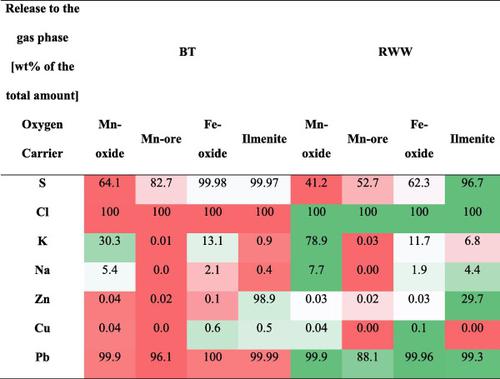Our official English website, www.x-mol.net, welcomes your feedback! (Note: you will need to create a separate account there.)
Thermodynamic analysis on the fate of ash elements in chemical looping combustion of solid fuels – Manganese-Based oxygen carriers
Fuel ( IF 7.4 ) Pub Date : 2024-04-15 , DOI: 10.1016/j.fuel.2024.131676 Ivana Staničić , Joakim Brorsson , Anders Hellman , Magnus Rydén , Tobias Mattisson
Fuel ( IF 7.4 ) Pub Date : 2024-04-15 , DOI: 10.1016/j.fuel.2024.131676 Ivana Staničić , Joakim Brorsson , Anders Hellman , Magnus Rydén , Tobias Mattisson

|
Chemical looping combustion (CLC) is an innovative technology suitable for converting waste-derived fuels into heat and power. The process inherently produces pure CO, which is highly favorable for carbon capture and storage and could be instrumental for achieving negative emissions. CLC operates by utilizing solid oxygen carriers (OCs) to transfer heat and oxygen between two reactors. The OC play a crucial role in achieving an efficient combustion. Manganese-based OCs are particularly interesting, due to their ability to release gaseous oxygen. However, ash components from solid fuels could alter their oxygen transfer capacity, and cause problems related to corrosion and agglomeration. The objective of this work is to obtain in-depth insights about Mn-based OCs for CLC of waste-derived fuels. This is achieved by investigating phase transitions during CLC of solid fuels when utilizing two manganese-based OCs: manganese oxide and a representative manganese ore. For this purpose, thermodynamic modeling is employed, and a specific focus is given to K, Na, Cu, Zn, and Pb, due to their important role in corrosion and/or agglomeration. Thermodynamic databases are expanded by calculating properties from first-principles. It is shown that Mn-based OCs are suitable for effectively converting waste-derived fuels while limiting corrosion. Furthermore, the iron in manganese ores is found to have positive implications for oxygen-transfer reactions. In terms of alkali release to the gas phase, manganese ore seems to be a more promising material compared to manganese oxide. The pathways for the heavy metals Zn, Cu, and Pb were, meanwhile, independent of the OC type.
中文翻译:

固体燃料——锰基载氧体化学循环燃烧中灰分元素归宿的热力学分析
化学循环燃烧(CLC)是一种创新技术,适用于将废物衍生燃料转化为热能和电力。该过程本身会产生纯二氧化碳,这非常有利于碳捕获和储存,并有助于实现负排放。 CLC 的运行原理是利用固体氧载体 (OC) 在两个反应器之间传递热量和氧气。 OC 在实现高效燃烧方面发挥着至关重要的作用。锰基有机碳特别令人感兴趣,因为它们能够释放气态氧。然而,固体燃料中的灰分成分可能会改变其氧传输能力,并导致与腐蚀和结块相关的问题。这项工作的目的是深入了解用于废物衍生燃料 CLC 的锰基 OC。这是通过研究固体燃料 CLC 过程中使用两种锰基 OC(氧化锰和代表性锰矿石)时的相变来实现的。为此,采用热力学模型,并特别关注 K、Na、Cu、Zn 和 Pb,因为它们在腐蚀和/或结块中发挥着重要作用。通过根据第一原理计算属性来扩展热力学数据库。结果表明,锰基有机碳适合有效转化废物衍生燃料,同时限制腐蚀。此外,锰矿石中的铁被发现对氧转移反应具有积极影响。就向气相释放碱而言,与氧化锰相比,锰矿石似乎是一种更有前景的材料。同时,重金属 Zn、Cu 和 Pb 的途径与 OC 类型无关。
更新日期:2024-04-15
中文翻译:

固体燃料——锰基载氧体化学循环燃烧中灰分元素归宿的热力学分析
化学循环燃烧(CLC)是一种创新技术,适用于将废物衍生燃料转化为热能和电力。该过程本身会产生纯二氧化碳,这非常有利于碳捕获和储存,并有助于实现负排放。 CLC 的运行原理是利用固体氧载体 (OC) 在两个反应器之间传递热量和氧气。 OC 在实现高效燃烧方面发挥着至关重要的作用。锰基有机碳特别令人感兴趣,因为它们能够释放气态氧。然而,固体燃料中的灰分成分可能会改变其氧传输能力,并导致与腐蚀和结块相关的问题。这项工作的目的是深入了解用于废物衍生燃料 CLC 的锰基 OC。这是通过研究固体燃料 CLC 过程中使用两种锰基 OC(氧化锰和代表性锰矿石)时的相变来实现的。为此,采用热力学模型,并特别关注 K、Na、Cu、Zn 和 Pb,因为它们在腐蚀和/或结块中发挥着重要作用。通过根据第一原理计算属性来扩展热力学数据库。结果表明,锰基有机碳适合有效转化废物衍生燃料,同时限制腐蚀。此外,锰矿石中的铁被发现对氧转移反应具有积极影响。就向气相释放碱而言,与氧化锰相比,锰矿石似乎是一种更有前景的材料。同时,重金属 Zn、Cu 和 Pb 的途径与 OC 类型无关。



























 京公网安备 11010802027423号
京公网安备 11010802027423号